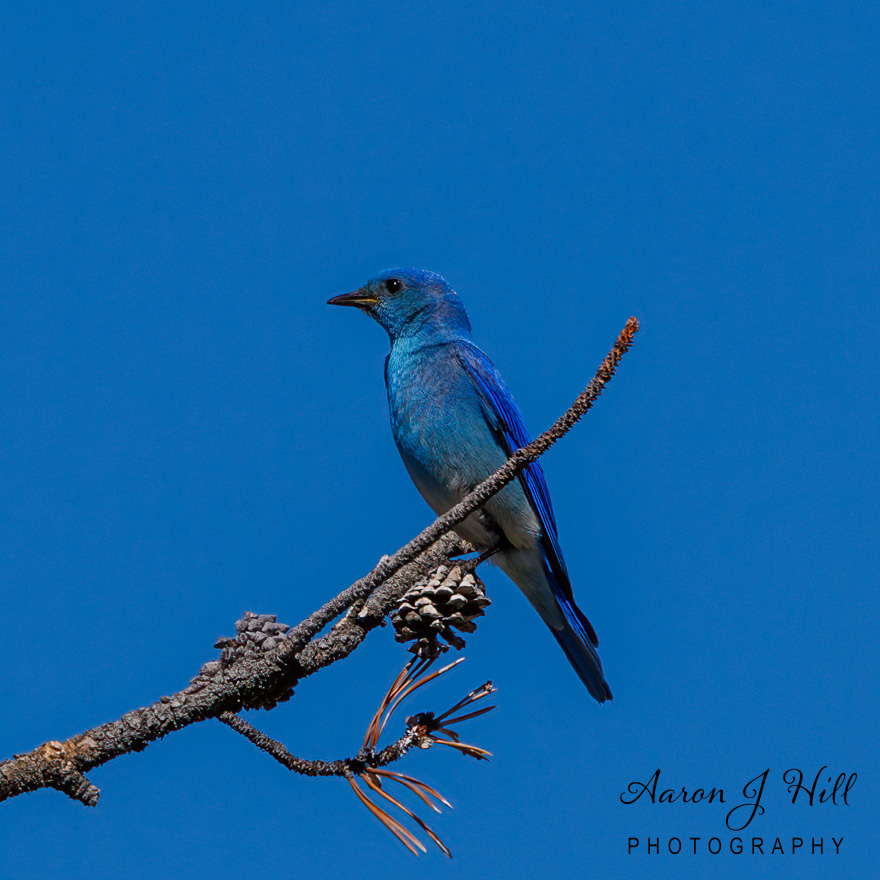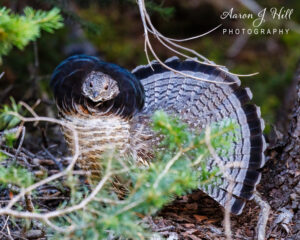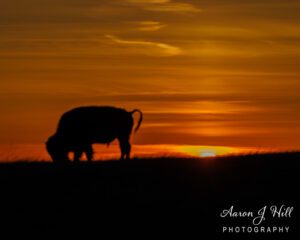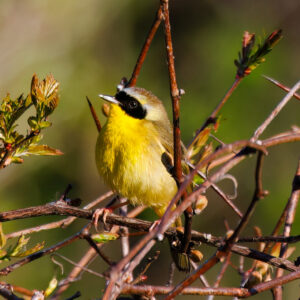The Mountain Bluebird (Sialia currucoides) is a captivating songbird native to North America. Renowned for its vibrant blue plumage and melodious call. This species holds a special place in the hearts of bird enthusiasts and photographers alike. In this comprehensive guide, we’ll explore various facets of the Mountain Bluebird’s life. Including its habitat, diet, breeding behaviors, and tips for capturing stunning photographs of these blue-colored birds.
Mountain Bluebird Identification
Mountain Bluebirds are easily recognized by its vibrant blue plumage and slender build. Adult males display a striking sky-blue coloration on their heads, backs, and wings, with a lighter blue extending to their underparts. Females, while more subdued, exhibit grayish-brown upperparts with tinges of blue on the wings and tail, and a pale gray breast. Both sexes have thin bills and black eyes. Juvenile Mountain Bluebirds resemble females but often have spotted breasts. Their distinctive coloration and preference for open habitats make them a favorite subject for birdwatchers and photographers seeking images of Mountain Bluebirds
Habitat and Distribution
Mountain Bluebirds inhabit open woodlands, grasslands, and alpine meadows across western North America. During the breeding season, they favor areas with a mix of short grasses, shrubs, and trees, often at elevations up to 12,500 feet. Their range extends from Alaska and western Canada through the Rocky Mountains and into the southwestern United States. In winter, they migrate to lower elevations, occupying open habitats such as prairies and desert grasslands.
Diet and Foraging Behavior
The Mountain Bluebird’s diet primarily consists of insects and berries. During the summer months, they feed heavily on insects like beetles, grasshoppers, caterpillars, and ants, which provide essential proteins for breeding and raising their young. In winter, when insect availability declines, they shift to consuming berries from plants such as juniper, mistletoe, and hackberry. This seasonal dietary flexibility enables them to thrive in diverse environments throughout the year.
Breeding and Nesting Habits
Mountain Bluebirds are cavity nesters, traditionally relying on tree cavities excavated by woodpeckers. However, they readily adapt to artificial nest boxes, especially in open areas with sparse tree cover. During courtship, males perform aerial displays and sing to attract females. Once a pair forms, the female constructs the nest using grasses, pine needles, and other plant materials. She lays a clutch of 4 to 6 pale blue eggs and incubates them for about two weeks. After hatching, both parents participate in feeding the chicks, which fledge approximately 18 to 21 days later.
Predators and Threats
Despite their vibrant appearance, Mountain Bluebirds face various natural predators. Raptors such as Sharp-shinned Hawks (Accipiter striatus), Cooper’s Hawks (Accipiter cooperii), Prairie Falcons (Falco mexicanus), and Peregrine Falcons (Falco peregrinus) pose significant threats, preying on both adults and fledglings. Additionally, nestlings are vulnerable to predation by snakes, squirrels, and domestic cats. Habitat loss and competition for nesting sites with other cavity-nesting species also present challenges to their populations.
Photographing Mountain Bluebirds
Capturing images of Mountain Bluebirds requires patience, preparation, and an understanding of their behaviors. Here are some tips to enhance your photography experience:
• Optimal Lighting
Early morning or late afternoon light provides a warm glow that enhances the bluebird’s vibrant plumage. Soft, diffused light during these times minimizes harsh shadows and highlights the bird’s natural colors.
• Understanding Behavior
Familiarize yourself with their foraging and perching habits. Mountain Bluebirds often hover over open fields before dropping to catch prey or perch on low branches and rocks. Observing these patterns can help you anticipate their movements and capture dynamic shots.
• Background and Composition
Aim for natural backgrounds that complement the bluebird’s coloration. Incorporate elements of their habitat, such as wildflowers or rustic fence posts, to add context and depth to your photos.
• Equipment and Settings
A telephoto lens (300mm or longer) allows you to photograph these birds without disturbing them. Use a fast shutter speed to freeze motion, especially during flight. Adjust your aperture to achieve a pleasing depth of field, keeping the bird in sharp focus while softly blurring the background.
• Ethical Considerations
Always maintain a respectful distance to avoid disrupting their natural behaviors, particularly during the breeding season. Avoid using playback calls excessively, as this can cause stress to the birds.
Mountain Bluebirds Conservation and Citizen Science
Mountain Bluebirds benefit from conservation efforts focused on providing nesting habitats, such as installing nest boxes in suitable open areas. Participating in citizen science projects, like monitoring bluebird nest boxes, contributes valuable data to ornithologists studying population trends and breeding success. Engaging in these activities supports the preservation of this species and offers rewarding opportunities to observe their life cycle up close.
Conclusion
The Mountain Bluebird, with its striking blue feathers and cheerful demeanor, embodies the beauty of North America’s open landscapes. Understanding their habitat preferences, diet, breeding behaviors, and the challenges they face enriches our appreciation of these remarkable birds. For photographers, capturing images of Mountain Bluebirds offers a fulfilling experience, blending the art of photography with the wonders of wildlife observation.
By supporting conservation initiatives and engaging in responsible photography practices, we can ensure that future generations continue to enjoy the presence of Mountain Bluebirds in our natural world.



